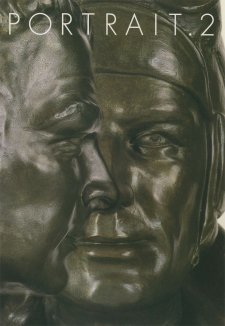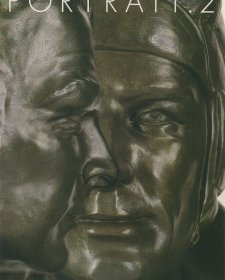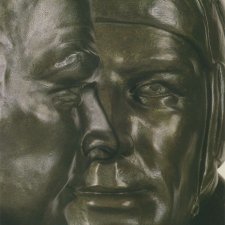The art of eX de Medici is immediately seductive. Her technical virtuosity renders details minute, obsessive, enthralling. Glorious pigments, intricate patterning are laid down for visual pleasure. Don’t get too comfortable though. Prepare for a jolt when the realisation of what you are looking at hits, sinks in. The apparent incongruity of method and meaning, surface and what lies beneath – which, once seen, you can’t take your eyes off.
Perhaps Midnight Oil operate a bit like this too. Spawned out of the Sydney pub rock scene of the late 70s and early 80s, they are, on first appearances, unlikely activists. Their messages are sustained through the music and the music is massively popular.
There there’s Peter Garrett’s head, that amazing skull. The commission recognises the contribution Midnight Oil has made to Australian music and activism. It is one of the most significant acquisitions of contemporary art in the Gallery’s history, made possible through the Basil Bressler Bequest to the Gallery for the purchase of works by living Australian artists.
In the portrait Midnight Oil is shown in front of the Ranger uranium mine at Kakadu in the Northern Territory. The drawing was made with quills cut by eX de Medici from the feathers of Wedge-tailed eagles using pigments obtained from the bark of mangrove trees found in the region.
eX de Medici is well acquainted with the Kakadu area. The landscape is a composite image constructed from detailed aerial photographs she took of the site. Two different shots of the Ranger Stage 3 mining pit were used as the basis of the foreground. The Ranger Stage 1 mining pit, parts of the processing plant, settlement ponds and surrounding mountain rage make up the background. The mountain in the background is Mount Brockman, in indigenous culture the place of the birth of the Rainbow Serpent and a funerary and mourning site.
The band (from left to right) Martin Rosey (guitar), Rob Hirst (drums, singing and percussion), Peter Garrett (singing and harmonica), Jim Moginie (guitar, singing, organ, autoharp and harmonium) and Bones Hillman (bass and singing) are painted from photographs taken at live gigs earlier this year at the Manly Leagues Club, the Metro Theatre and at a studio session in Sydney. The smaller and somewhat curious group of figures behind the band are Gary Morris, the Oils’ manager and ‘sixth member of the band’, with the office and management team from past to present Stephanie Lewis, Diana Lindsay and Arlene Brooks, also worked up from photographs.
On first encounter one is captivated, stunned by the object itself: a perspex box containing an obscenely large sheet of vellum (actually six sheets sewn together), a blood-red landscape, clotted, expansive, incredibly detailed, impossible to decipher in that first wonderful glance, a group of heads, at least one that you probably recognise, and those five sets of eyes, remarkably clear, focused, staring straight out at you.
On the neck of each member of the band the artist has ‘embroidered’ wing markings from five moth species known to have existed in the Ranger area. To eX de Medici they are included to represent ‘a tiny aspect in the disruption of the biodiversity of the landscape. The big and the small’. They are also an extension of work Sp. Which she has developed during an artist in residence program at the CSIRO Entomology’s Australian National Insect Collection. Particularly the drawings of broad arrows which, eX de Medici pointed out are ‘the empirical signifier of British colonisation in Australia... a metaphor for property and project of government. The broad arrow is also a weapon.’
There are many other links to eX de Medici’s broader artistic concerns in the portrait, perhaps most obviously working on skin which literally refers to the process of tattooing. Other narratives lie beneath the detail and colour on vellum, complex challenging symbols and associations lead us along the winding roads carved into the mine pit and into the heart ‘the dead heart’ of the landscape.
‘Nothings as precious as a hole in the ground’, Midnight Oil sing in Blue Sky mine, a song about greed, exploitation of workers, local communities and the environment. The substance beneath the scarred and stratified surface is precious, certainly, but the land at Ranger uranium mine in Kakadu does have a price, $8.75US per pound.














